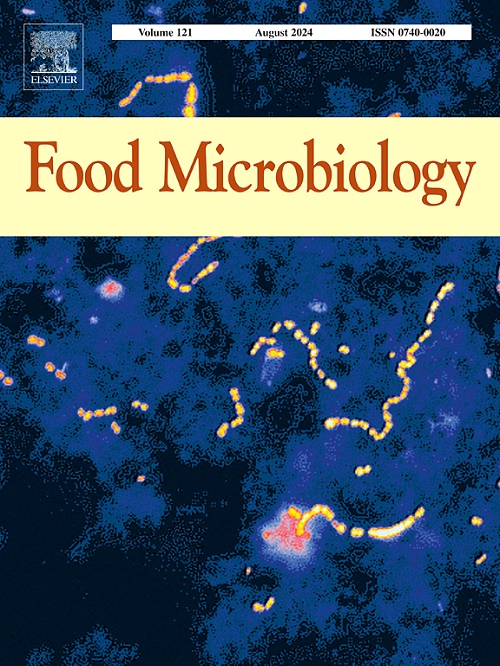用商品噬菌体制剂控制牛奶和生奶干酪中的肠沙门氏菌
IF 4.5
1区 农林科学
Q1 BIOTECHNOLOGY & APPLIED MICROBIOLOGY
引用次数: 0
摘要
与食用原料奶和由原料奶制成的奶酪有关的沙门氏菌病疫情继续发生,这突出表明需要采取额外的控制措施。本研究确定了选定的9种肠道沙门氏菌血清型对市售噬菌体制剂的敏感性,以及噬菌体应用对巴氏杀菌和原料奶中沙门氏菌的控制效果。除serovar Cerro外,SalmoFresh™和PhageGuard S™均表现出较高的裂解效率。肉汤微量稀释试验确定感染多重度(MOI)范围为log 1.84-6.69,在血清型和产品之间有所不同。将SalmoFresh™噬菌体产品添加到MOI为log6的巴氏杀菌奶中,迅速降低了沙门氏菌计数,在7°C条件下,7天后沙门氏菌平均计数比对照组低2.33-3.22 logcfu /mL。除了serovar Cerro外,SalmoFresh™在原料奶中也有效,在储存结束时平均计数比对照组低1.12-2.27 log CFU/mL。尽管有这些观察结果,当SalmoFresh™添加到log MOI 6时,蒙得维的亚沙门氏菌的计数在干酪制作或在7°C下储存28 d时与对照没有差异。将SalmoFresh™添加到牛奶中,在log MOI为6时,腌制前的豪达干酪中的沙门氏菌计数较低,而在log MOI为6或7时,在一周前的陈年豪达干酪中检测不到沙门氏菌计数。这些数据表明,商业噬菌体产品有潜力提高原料奶的安全性,包括用于生产奶酪的原料奶。本文章由计算机程序翻译,如有差异,请以英文原文为准。
Control of Salmonella enterica spp. enterica in milk and raw milk cheese using commercial bacteriophage preparations
Outbreaks of salmonellosis linked to consumption of raw milk and cheese made from raw milk continue to occur, highlighting the need for additional controls. This study determined the susceptibility of nine selected serovars of Salmonella enterica spp. enterica to commercially available bacteriophage preparations as well as the efficacy of phage application to control Salmonella in pasteurized and raw milk during storage and in the production of raw milk queso fresco and Gouda cheese. Except for serovar Cerro, both SalmoFresh™ and PhageGuard S™ demonstrated high lytic efficiency. Broth microdilution assays identified multiplicities of infection (MOI) ranging from log 1.84–6.69, which varied between serovars and products. Addition of SalmoFresh™ phage product to pasteurized milk at log MOI 6 rapidly reduced Salmonella counts such that mean counts were 2.33–3.22 log CFU/mL lower than control after 7 d at 7 °C. Aside from serovar Cerro, SalmoFresh™ addition was also effective in raw milk with mean counts 1.12–2.27 log CFU/mL lower than control at the end of storage. Despite these observations, counts of Salmonella Montevideo did not differ from control during queso fresco production or storage at 7 °C for 28 d when SalmoFresh™ was added at log MOI 6. Salmonella counts were lower in Gouda before brining when SalmoFresh™ was added to milk at log MOI 6 and was undetectable one week earlier in aged Gouda when added at log MOI 6 or 7. These data demonstrate the potential of commercial phage products to enhance the safety of raw milk, including that used to produce cheese.
求助全文
通过发布文献求助,成功后即可免费获取论文全文。
去求助
来源期刊

Food microbiology
工程技术-生物工程与应用微生物
CiteScore
11.30
自引率
3.80%
发文量
179
审稿时长
44 days
期刊介绍:
Food Microbiology publishes original research articles, short communications, review papers, letters, news items and book reviews dealing with all aspects of the microbiology of foods. The editors aim to publish manuscripts of the highest quality which are both relevant and applicable to the broad field covered by the journal. Studies must be novel, have a clear connection to food microbiology, and be of general interest to the international community of food microbiologists. The editors make every effort to ensure rapid and fair reviews, resulting in timely publication of accepted manuscripts.
 求助内容:
求助内容: 应助结果提醒方式:
应助结果提醒方式:


